Diuqin
- unexpecteddinolesson
- Jun 14, 2024
- 3 min read
Updated: Jun 20, 2024
MEANING: Bird of prey
PERIOD: Late Cretaceous
CONTINENT: South America
Diuqin is an unenlagiine dinosaur from the Late Cretaceous of what is now Argentina. Unenlagiines, known exclusively from South America, are usually classified as dromaeosaurs though this is sometimes debated. Like dromaeosaurs, they were covered in feathers, carnivorous, and had the large sickle-like claw on the inner toe of each foot. Unique to unenlagiines is their elongated snout, suggesting a piscivorous diet. Diuqin was a medium-sized unenlagiine, at about 4 m in length.

Abstract from paper: Unenlagiine paravians are among the most relevant Gondwanan theropod dinosaur clades for understanding the origin of birds, yet their fossil record remains incomplete, with most taxa being represented by fragmentary material and/or separated by lengthy temporal gaps, frustrating attempts to characterize unenlagiine evolution.
Here we describe Diuqin lechiguanae gen. et sp. nov., a new unenlagiine taxon from the Upper Cretaceous (Santonian) Bajo de la Carpa Formation of the Neuquén Basin of Neuquén Province in northern Patagonia, Argentina that fills a substantial stratigraphic gap in the fossil record of these theropods. Although known only from a very incomplete postcranial skeleton, the preserved bones of Diuqin differ from corresponding elements in other unenlagiines, justifying the erection of the new taxon. Moreover, in several morphological aspects, the humerus of Diuqin appears intermediate between those of geologically older unenlagiines from the Neuquén Basin (e.g., Unenlagia spp. from the Turonian–Coniacian Portezuelo Formation) and that of the stratigraphically younger, larger-bodied Austroraptor cabazai from the Campanian–Maastrichtian Allen Formation. Consequently, the morphology of the new taxon appears to indicate a transitional stage in unenlagiine evolution. Phylogenetic analysis recovers Diuqin as a paravian with multiple plausible systematic positions, but the strongest affinity is with Unenlagiinae. The humerus of the new form exhibits subcircular punctures near its distal end that are interpreted as feeding traces most likely left by a conical-toothed crocodyliform, mammal, or theropod, the latter potentially corresponding to a megaraptorid or another unenlagiine individual. Thus, in addition to filling important morphological and temporal gaps in unenlagiine evolutionary history, the new taxon also offers information relating to the paleoecology of these theropods.
Diuqin is from the Cretaceous. The Cretaceous is a geological period that lasted from about 145 to 66 million years ago. It is the third and final period of the Mesozoic Era, as well as the longest. At around 79 million years, it is the longest geological period of the entire Phanerozoic. The name is derived from the Latin creta, "chalk", which is abundant in the latter half of the period.
The Cretaceous was a period with a relatively warm climate, resulting in high eustatic sea levels that created numerous shallow inland seas. These oceans and seas were populated with now-extinct flora and fauna, while dinosaurs continued to dominate on land. The world was ice free, and forests extended to the poles. During this time, new groups of mammals and birds appeared. During the Early Cretaceous, flowering plants appeared and began to rapidly diversify, becoming the dominant group of plants across the Earth by the end of the Cretaceous, coincident with the decline and extinction of previously widespread gymnosperm groups.
The Cretaceous (along with the Mesozoic) ended with the Cretaceous–Paleogene extinction event, a large mass extinction in which many groups, including non-avian dinosaurs, pterosaurs, and large marine reptiles, died out. The end of the Cretaceous is defined by the abrupt Cretaceous–Paleogene boundary (K–Pg boundary), a geologic signature associated with the mass extinction that lies between the Mesozoic and Cenozoic Eras.
Diuqin is a dromaeosaur. Dromaeosauridae is a family of feathered theropod dinosaurs that flourished in the Cretaceous Period. The name Dromaeosauridae means 'running lizards'. Dromaeosaurids were small to medium-sized carnivores, ranging from about 0.5 to 6 meters in length. Smaller species included Microraptor and Velociraptor, while larger examples included species such as Utahraptor, Dakotaraptor and Achillobator.
The dromaeosaurid body plan includes a relatively large skull, serrated teeth, narrow snout, and forward-facing eyes which indicate some degree of binocular vision. The distinctive dromaeosaurid body plan helped to rekindle theories that dinosaurs may have been active, fast, and closely related to birds. Dromaeosaurids, like most other theropods, had a moderately long S-curved neck, and their trunk was relatively short and deep. They had long arms that could be folded against the body in some species, and relatively large hands with three long fingers ending in large claws. Their tails were long and slender, which helped them balance and quickly maneuver during locomotion.
Dromaeosaurid feet had an enlarged second toe, bearing an unusually large, curved, sickle-shaped claw, which was held off the ground or 'retracted' when walking. This distinctive claw is thought to have been used in capturing prey and climbing trees. It was especially blade-like in the large-bodied predatory eudromaeosaurs.









